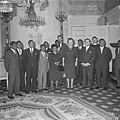New Guinea Council | |
|---|---|
 | |
| History | |
| Succeeded by | Papua House of Representatives West Papua Regional House of Representatives |
| Leadership | |
Chair | Frits Sollewijn Gelpke |
Vice-Chair | |
Clerk | J. W. Trouw |
| Seats | 28 |
| Elections | |
| 16 elected | |
| 12 appointed | |
Last election | 1961 |
| Meeting place | |
 | |
| Hollandia | |
The New Guinea Council (Dutch : Nieuw-Guinea Raad) was a unicameral representative body formed in the Dutch overseas territory of Netherlands New Guinea in 1961.






